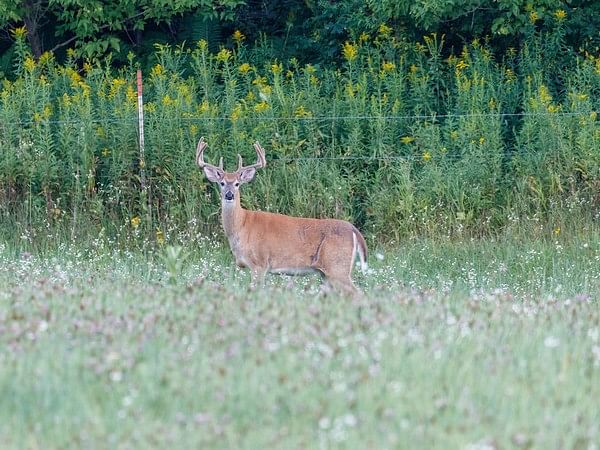Ithaca (New York) [US], February 1 (ANI): The spread of severe acute respiratory syndrome coronavirus 2 (SARS-CoV-2) from humans to white-tailed deer (WTD) and its ability to transmit from deer to deer raised concerns about the role of WTD in the epidemiology and ecology of the virus.
A study found that White-tailed deer may serve as a wildlife reservoir for SARS-CoV-2 strains that no longer circulate in humans.
White-tailed deer are highly susceptible to SARS-CoV-2 infection, highlighting the need to establish surveillance programs that continuously monitor the circulation, distribution, and evolution of this pathogen in wildlife populations. Diego Diel and colleagues assessed the prevalence, genetic diversity, and evolution of SARS-CoV-2 in white-tailed deer in New York. The authors tested 5,462 retropharyngeal lymph node samples collected from the deer during the hunting seasons of 2020 and 2021.
COVID-19 was declared a pandemic in March 2020 and as of January 2023 has incurred over 659 million human cases and more than 6.6 million deaths globally.
COVID-19 is caused by severe acute respiratory syndrome coronavirus 2 (SARS-CoV-2), a new zoonotic virus for which most of the first known human infections were linked to the Huanan Seafood Wholesale Market in Wuhan, China, where several live wild animal species were sold. SARS-CoV-2 is a single-stranded RNA virus within the Sarbecovirus subgenus, Betacoronavirus genus, of the family Coronaviridae.
Analysis of the genome sequence of SARS-CoV-2 revealed high similarity to coronaviruses circulating in bats in China, suggesting that bats are the most likely source of the ancestral virus that originated SARS-CoV-2. While the closest bat coronaviruses (RaTG13, RmYN02, RpYN06, and PrC31) are phylogenetically related to SARS-CoV-2, they present several mutations across the genome that distinguish them from SARS-CoV-2, indicating that direct transmission of the virus from bats to humans was unlikely. These observations point to the involvement of a yet unidentified animal species that served as an intermediate host and enabled spillover of the virus into humans.
Comparative sequence analyses of the main cellular receptor for SARS-CoV-2, the angiotensin-converting enzyme 2 (ACE2), from more than 400 animal species suggested a broad host range for the virus. Notably, the ACE2 of three species of deer, including reindeer (Rangifer tarandus), Pere David’s deer (Elaphurus davidianus), and white-tailed deer (WTD) (Odocoileus virginianus), share a high similarity to the human ACE2 and were predicted to allow binding and entry of SARS-CoV-2 into deer cells. The study have confirmed these in silico predictions and demonstrated that WTD are highly susceptible to SARS-CoV-2 infection. Most importantly, intranasal inoculation of SARS-CoV-2 in WTD resulted in virus replication and shedding, which led to efficient deer-to-deer transmission.
The authors identified hotspots of infection in multiple confined geographic areas. Fewer than 1 per cent of samples were positive in 2020, compared with 21 per cent in 2021. Sequence analysis of SARS-CoV-2 genomes from 164 samples demonstrated the cocirculation of three major variants of concern: Alpha, Gamma, and Delta. The results revealed multiple human-to-deer spillover events of the Alpha and Delta lineages, with subsequent deer-to-deer transmission and rapid adaptation of the viruses. According to the authors, the findings underscore the need for measures to minimize additional virus introductions in animals that may lead to spillback of novel deer-adapted SARS-CoV-2 variants to humans. (ANI)
This report is auto-generated from ANI news service. ThePrint holds no responsibility for its content.



